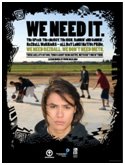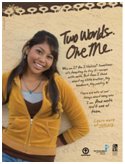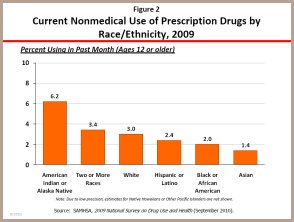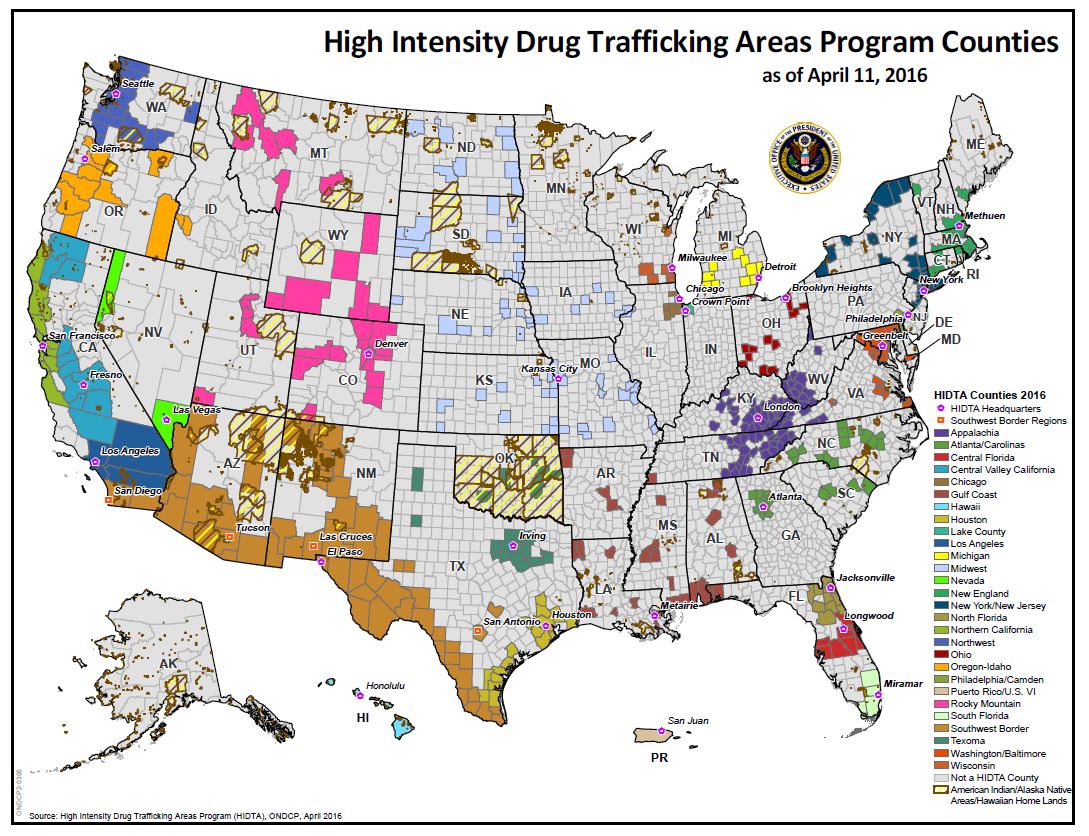Collaborating with Native Americans and Alaskan Natives
Drug abuse exacts a heavy toll among Native Americans and Alaskan Natives in the United States. In response, ONDCP is developing programs and policies tailored to Indian Country and designed to assist Tribal authorities using a balanced strategy of prevention, treatment, recovery support, and law enforcement.
Research and Statistics
Recent data report high usage of illicit drugs by Native Americans and outline the need for targeted resources and outreach:
- According to the 2009 National Survey on Drug Use and Health, 18.3 percent of American Indians/Alaskan Natives age 12 or older are current users of illicit drugs, meaning they used illicit drugs within 30 days prior to responding to the survey (see figure 1).
- Native American and Alaskan Native populations also show high percentages of lifetime (64.8 percent), past year (27.1 percent) illicit drug use, and current non-medical use of prescription drugs (6.2 percent), as shown in figure 2.
Click to enlarge.
Prevention Programs
ONDCP has a number of ongoing programs and initiatives that provide support and resources to encourage healthy and safe Native American communities:
-
The National Youth Anti-Drug Media Campaign researches, develops, and delivers relevant and appropriate anti-drug messages. Launched in early 2008 and continuing today, the Anti-Meth Campaign emphasizes Native American culture and pride through print, radio, and television ads. It is the only national anti-meth ad campaign concentrating on Indian Country and Native Alaskan lands.
Here are several of the Campaign's print ads that celebrate Native pride over meth use among Native American populations:


The Campaign has partnered with the National Congress of American Indians, the Department of the Interior, the Department of Health and Human Services, and the the Partnership at DrugFree.org to develop a public awareness advertising campaign focusing on preventing methamphetamine use among Native American populations.
- The Drug Free Communities (DFC) Support Program engages Native Americans and Alaskan Natives in community efforts to reduce youth drug and alcohol use. Eighty-five DFC-funded coalitions have served American Indian/Alaskan Native communities since 2006. Currently, Native populations are being served by 66 DFC-funded coalitions, a total of $6.1 million goes to fund these coalitions. Tribal representation in the DFC program has grown from 1.9 percent in 2006 to 9.1 percent in 2009 – a five-fold increase. ONDCP continues to partner with Indian Country to increase capacity and participation through numerous workshops, training sessions, and coalition-building conferences. To learn more about the DFCs in your area, view the list of grantees.
Treatment, Early Intervention and Recovery
- The President's Access to Recovery (ATR) grant program individualizes substance use treatment, recovery, and support services, and addresses the cultural and geographic unique needs of American Indian/Alaskan Native communities. In 2010, ATR grants totaling $15.2 million (over five years) were awarded to five Tribal organizations covering Indian Country populations, including the: California Rural Indian Health Board; Montana Wyoming Tribal Leaders Council; Inter-Tribal Council of Michigan; Oglala Sioux Tribal Council in South Dakota; and Aberdeen Area Tribal Chairmen's Health Board in South Dakota.
- Tribal Drug Courts, which refer people with substance use disorders in the criminal justice system to treatment and recovery services in lieu of jail, play an important role in breaking the cycle of drug use and crime. As of December 31, 2009, there were 89 Tribal Drug Courts, nearly twice the number (45) in 2001. Currently, Indian tribal governments may apply for drug court funding through the Bureau of Justice Assistance's Drug Court Discretionary Grant Program.
Partnering with Indian Country Leadership and Law Enforcement
Drug trafficking is a significant problem in Indian Country, and ONDCP has made it a priority to collaborate with tribal leadership to enhance law enforcement and prevention responses. HIDTAs are uniquely positioned to work with local and tribal communities to promote and participate in community-based drug prevention programs. Initially funded by ONDCP FY 2014 discretionary grant, the SWB – New Mexico Region continues to assist the Rio Arriba Community Empowerment Project with prevention efforts in Rio Arriba County, NM. The project will also assist both the Pojoaque and Santa Clara tribes. Currently, 10 HIDTA programs are collaborating in enforcement operations and training with Tribal Nations: Atlanta-Carolinas, Nevada, New York/New Jersey, Northern California, Northwest, Oregon, SWB Arizona Region, SWB New Mexico Region, Texoma, and Wisconsin.
Additional Resources
- 2011 National Drug Control Strategy – The Administration's balanced and comprehensive approach to drug control.
-
ONDCP Fact Sheets, including:
- 2010 National Native American Anti-Meth Campaign
- Back to School: Keeping Our Children Safe, Healthy, and Drug-Free in the New School Season
- Drug Courts A Smart Approach to Criminal Justice
- Drug Free Community Support Program
- High Intensity Drug Trafficking Areas (HIDTA) program
- Methamphetamine Trends in the United States
- National Youth Anti-Drug Media Campaign
- Prescription Drugs: Weighing the Benefits and the Risks
- U.S. Response To Security Threats Along The Southwest Border
- Working To Get Drugged Drivers Off The Road
-
Federal Agencies with partner programs:
- Department of the Interior, Bureau of Indian Affairs
- Indian Health Service, Behavioral Health and Suicide Prevention webpages
- Substance Abuse and Mental Health Services, Native National Resource Center and Suicide Prevention Resource Center
- Department of Justice, Office of Tribal Justice



